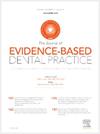口腔内相机和智能手机相机在成人龋齿远程检测中的准确性:一项诊断准确性研究
IF 4
4区 医学
Q1 DENTISTRY, ORAL SURGERY & MEDICINE
引用次数: 0
摘要
背景与目的ele-dentistry将电信与牙科相结合,传输临床数据,用于远程会诊和治疗计划。它改善了筛查、转诊和治疗的牙科保健机会。本研究旨在测试口腔内相机和智能手机相机在埃及亚历山大成年人中诊断空化龋齿病变的准确性。方法对在亚历山大大学牙科学院就诊的18岁以上成人进行诊断准确性研究,比较两种不同的远程口腔龋检测方法(C50全高清荧光口腔内相机)和智能手机相机(三星Galaxy A24),并将参与者随机分为两组。参照标准为面对面考核。根据国际龋齿检测和评估系统(ICDAS),通过临床检查、口腔内相机视频和智能手机照片进行龋齿诊断。计算两种方法在牙齿和表面水平的敏感性、特异性、准确性、阳性预测值和阴性预测值。结果该研究包括50名成年人。年龄层(26-40岁)占参与者的46%。两种相机均具有较高的特异性和准确性(>90%)。口腔内相机( = 84.62%)和智能手机( = 79.52%)对空化病变的检测灵敏度最低。智能手机相机在牙齿(49.3%)和表面(58.4%)水平上的精度最低。结论口腔内相机对口腔表面蛀牙的检测精度高于智能手机相机。虽然口腔内相机是首选的方式,但智能手机相机提供了一种更容易获得和更具成本效益的替代方案,特别是在资源有限的环境中。然而,应该承认它们的局限性。本文章由计算机程序翻译,如有差异,请以英文原文为准。
ACCURACY OF INTRAORAL CAMERA AND SMARTPHONE CAMERA IN TELEDETECTION OF DENTAL CARIES AMONG ADULTS: A DIAGNOSTIC ACCURACY STUDY
Background and Objectives
Tele-dentistry combines telecommunications and dentistry to transmit clinical data for remote consultation and treatment planning. It improves dental care access for screening, referrals, and treatment. This study aimed to test the accuracy of intraoral camera and smartphone camera in the diagnosis of cavitated carious lesions among adults in Alexandria, Egypt.
Methods
A diagnostic accuracy study was conducted on adults above 18 years old visiting clinics of the Faculty of Dentistry, Alexandria University to compare 2 different tele-dentistry caries detection methods (intraoral camera (C50 Full HD with fluorescence) and smartphone camera (Samsung Galaxy A24) after randomizing the participants into 2 groups. The reference standard was face-to-face examination. The caries diagnosis was based on the International Caries Detection and Assessment System (ICDAS) through clinical examination, intraoral camera videos, and smartphone photos. Sensitivity, specificity, accuracy, positive and negative predictive values were calculated for the 2 methods at tooth and surface levels.
Results
The study included 50 adults. The age group (26-40) comprised (46%) of the participants. Both cameras had high specificity and accuracy (>90%). The lowest sensitivity was in the case of detecting cavitated lesions at surface level (intraoral camera = 84.62% and smartphone = 79.52%). The smartphone camera had the lowest precision at both tooth (49.3%) and surface (58.4%) levels."
Conclusion
The intraoral camera showed higher accuracy than the smartphone camera especially in detecting cavitated carious lesions at surface level. While intraoral cameras are the preferred modality, smartphone cameras provide a more accessible and cost-effective alternative, especially in resource-limited settings. However, their limitations should be acknowledged.
求助全文
通过发布文献求助,成功后即可免费获取论文全文。
去求助
来源期刊

Journal of Evidence-Based Dental Practice
DENTISTRY, ORAL SURGERY & MEDICINE-
CiteScore
6.00
自引率
16.70%
发文量
105
审稿时长
28 days
期刊介绍:
The Journal of Evidence-Based Dental Practice presents timely original articles, as well as reviews of articles on the results and outcomes of clinical procedures and treatment. The Journal advocates the use or rejection of a procedure based on solid, clinical evidence found in literature. The Journal''s dynamic operating principles are explicitness in process and objectives, publication of the highest-quality reviews and original articles, and an emphasis on objectivity.
 求助内容:
求助内容: 应助结果提醒方式:
应助结果提醒方式:


